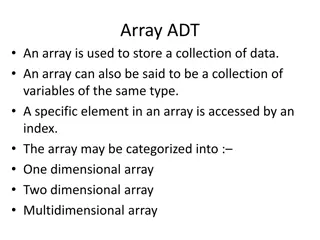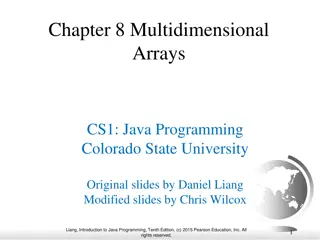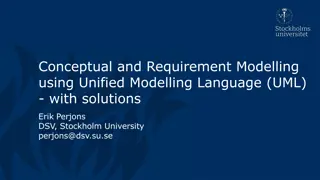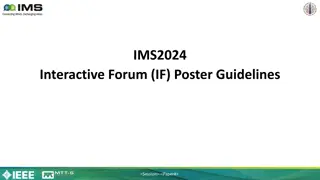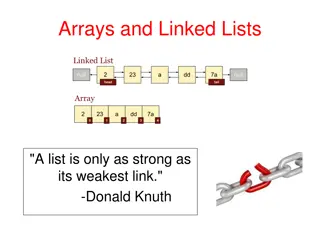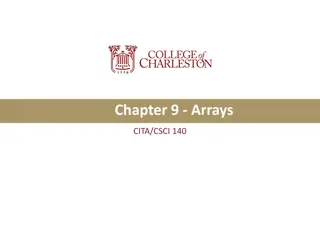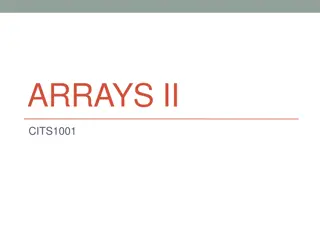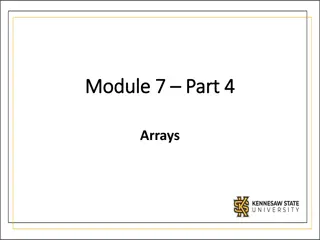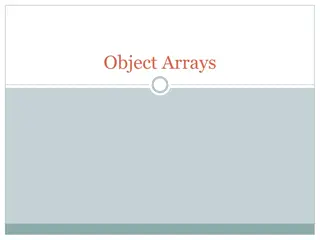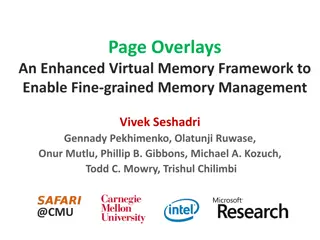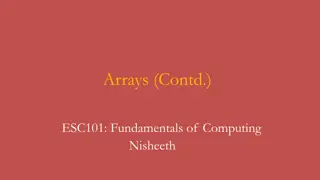Modelling and Exploration of Coarse-Grained Reconfigurable Arrays Using CGRA-ME Framework
This content discusses the CGRA-ME framework for modelling and exploration of Coarse-Grained Reconfigurable Arrays (CGRA). It covers the objectives, architecture description, inputs required, and tools included in the framework. CGRA-ME allows architects to model different CGRA architectures, map applications onto CGRAs, simulate and verify applications, and realize CGRAs as ASIC or FPGA overlays.
Download Presentation

Please find below an Image/Link to download the presentation.
The content on the website is provided AS IS for your information and personal use only. It may not be sold, licensed, or shared on other websites without obtaining consent from the author.If you encounter any issues during the download, it is possible that the publisher has removed the file from their server.
You are allowed to download the files provided on this website for personal or commercial use, subject to the condition that they are used lawfully. All files are the property of their respective owners.
The content on the website is provided AS IS for your information and personal use only. It may not be sold, licensed, or shared on other websites without obtaining consent from the author.
E N D
Presentation Transcript
1 Modelling and Exploration of Coarse-Grained Reconfigurable Arrays: Using the Open-Source CGRA-ME Framework Omar Ragheb, Stephen Wicklund, Kentaro Sano1, Jason Anderson DATE 24 Tutorial, Valencia, Spain March 26, 2024
2 CGRA Challenges Architectures less studied than competing platforms, such as FPGAs or GPGPUs CAD tool development required CGRAs: ??? GPUs: GPGPU-Sim FPGAs: Verilog-to-Routing Processors: gem5
3 Introduction to CGRA-ME CGRA-ME: an open-source modelling and exploration framework for CGRA architecture and CAD exploration Objectives: Allow an architect to model a wide range of CGRA architectures via a C++ API Allow an application, described in a high-level language, to be mapped onto the modelled CGRA Area, performance, and power modelling of the CGRA for an application This allows for: Simulation and verification of application on modelled CGRA Physical realization of CGRA as an ASIC or FPGA overlay
CGRA-ME: Framework CGRA Architecture Description Architecture Constraints Benchmark CGRA Architecture Interpreter LLVM Verilog RTL for CGRA Device Model of Architecture Data-Flow Graph of Application Std. Cell Synthesis Place and Route FPGA Synthesis Place and Route Bitstream Verilog Simulation Mapper Functional Verification Standard-Cell CGRA Perf, Power & Area FPGA-Overlay CGRA Perf, Power & Area
CGRA-ME: Inputs CGRA Architecture Description Architecture Constraints Benchmark CGRA-ME Framework takes in three input files which are: Benchmark: C code application that needs acceleration Example benchmarks are machine learning, signal processing, image processing, Architecture Constraints: A constraint file that specifies the routing constraints and the fixed ports. Architecture description: A C++ description of an CGRA architecture (specified using CGRA-ME s API)
CGRA-ME: Architecture Description CGRA Architecture Description Architecture Constraints Benchmark CGRA Architecture Interpreter LLVM Verilog RTL for CGRA Device Model of Architecture Data-Flow Graph of Application Std. Cell Synthesis Place and Route FPGA Synthesis Place and Route Bitstream Verilog Simulation Mapper Functional Verification Standard-Cell CGRA Perf, Power & Area FPGA-Overlay CGRA Perf, Power & Area
7 Architecture Description As a user of CGRA-ME, there are two aspects of architecture that you need to describe The first is the content of the Processing Element (PE) The second is the PE matrix and the interconnect connecting the constituent PEs.
RIKEN PE Instantiate Submodules MUX A buff A FP Wrapper Crossbar (SB) buff Out IMM fork Join buff B MUX B addSubModule(new ElasticBufferFIFO( buff_A", loc, buffer_depth, 32)); addSubModule(new ElasticBufferFIFO( buff_b", loc, buffer_depth, 32)); addSubModule(new Multiplexer( MUX_A", loc, num_inputs + 2)); addSubModule(new Multiplexer( MUX_B", loc, num_inputs + 2)); addSubModule(new ConstUnit( IMM", loc, 32)); addSubModule(new ElasticFPFuncUnit( FPALU", loc, Op-list, 32, latency));
RIKEN PE Interconnect Modelling MUX A buff A FP Wrapper Crossbar (SB) buff Out IMM fork Join buff B MUX B connectPorts( crossbar.out + num_outports - 1, buff_A.in , isElastic); connectPorts( crossbar.out + num_outports, buff_B.in , isElastic); connectPorts( buff_A.out , MUX_A.in0 , isElastic); connectPorts( buff_B.out , MUX_B.in0 , isElastic); connectPorts( MUX_A.out , join.in0 , isElastic); connectPorts( MUX_B.out , join.in1 , isElastic);
RIKEN PE Add Configuration Bits MUX A buff A FP Wrapper Crossbar (SB) buff Out IMM fork Join buff B MUX B addConfig( MUXAConfig , { MUX_A.select }, isElastic); addConfig( MUXBConfig , { MUX_B.select }, isElastic); addConfig( IMMForkConfig , { Imm_fork.enable_downstream }, isElastic); addConfig( IMMConfig , { Imm.in }, isElastic); addConfig( FPALUConfig , { FPALU.select }, isElastic);
11 Main C++ Function Calls Instantiating submodules addSubModule(new $(Module Class)($(Name), $(location), $(other args))); Connecting ports connectPorts($(Source Port Name), $(Sink Port Name), $(elastic bool)); Adding configuration bits addConfig($(Config Name), $(Config Port Name), $(elastic bool));
CGRA Instantiate PE Matrix for (unsigned int c = 0; c < cols; c++) { for (unsigned int r = 0; r < rows; r++) { addSubModule(new ProcessingElement( PE_ + r + c)); } }
CGRA Instantiate PE Matrix IO Port Mem Port IO Port Mem Port IO Port Mem Port IO Port Mem Port Next steps for a full architecture model: Interconnect the PE Matrix Add IO ports Add Memory Ports
CGRAs Modelled within CGRA-ME There are three main CGRAs modelled within CGRA- ME 2.0 release ADRES HyCUBE RIKEN Elastic RIKEN ADRES
15 Architecture Modelling Summary CGRA-ME provides a C++ API that allows one to: Instantiate a variety of primitives ALUs, Constants, Buffers, Registers, Connect primitives to one another: Crossbars, Direct connections, MUXes, Add configurability for the interconnect/primitives With API, one can model wide range of different CGRAs Limitations/ongoing work: Modelling predication, mixed bitwidth CGRAs and etc.
CGRA-ME: DFG generation CGRA Architecture Description Architecture Constraints Benchmark CGRA Architecture Interpreter LLVM Verilog RTL for CGRA Device Model of Architecture Data-Flow Graph of Application Std. Cell Synthesis Place and Route FPGA Synthesis Place and Route Bitstream Verilog Simulation Mapper Functional Verification Standard-Cell CGRA Perf, Power & Area FPGA-Overlay CGRA Perf, Power & Area
17 DFG Extraction CGRA-ME Front-end data-flow graph extraction -- LLVM State-of-the-art compiler used by Apple, NVIDIA, Xilinx, Intel, etc Leverage LLVM language support, parsing and optimizations In LLVM, the program is represented in an Intermediate Representation (IR) Machine-independent assembly code Limited instruction set: add, xor, branch, mul, div Target inner-loop kernels for mapping to CGRAs
18 Data-Flow Graph Extraction //DFGLoop: loop : marks the loop to be extracted
19 Data-Flow Graph Visualization DFG is a directed graph made up of: Nodes N Const0 i6_add i4_load i5_add i5_output
20 Data-Flow Graph Visualization DFG is a directed graph made up of: Nodes N Edges E Const0 i6_add i4_load i5_add i5_output
CGRA-ME: Device Model Graph CGRA Architecture Description Architecture Constraints Benchmark CGRA Architecture Interpreter LLVM Verilog RTL for CGRA Device Model of Architecture Data-Flow Graph of Application Std. Cell Synthesis Place and Route FPGA Synthesis Place and Route Bitstream Verilog Simulation Mapper Functional Verification Standard-Cell CGRA Perf, Power & Area FPGA-Overlay CGRA Perf, Power & Area
22 Device Model Graph: Nodes Each node is in one of three types. Functional node Represent units that execute instructions such as add, mul, PHI Routing node Nodes that create links between different functional or memory nodes Memory node Nodes that can store data for 1 or more clock cycles
23 Device Model Graph: Modulo Routing Resource Graph (MRRG) Generalizable handles multiple types of primitives Piecemeal construction Registers are handled differently FU REG From previous clock cycle To next clock cycle Example Block
24 LLVM IR-based Functional Units We align the functionality specification of CGRA blocks with the LLVM IR computational instructions Example Block mul | add | mul->add FU REG The capabilities of the architecture are expressed in the same instruction set as the compiler to the architecture
CGRA-ME: Mapping CGRA Architecture Description Architecture Constraints Benchmark CGRA Architecture Interpreter LLVM Verilog RTL for CGRA Device Model of Architecture Data-Flow Graph of Application Std. Cell Synthesis Place and Route FPGA Synthesis Place and Route Bitstream Verilog Simulation Mapper Functional Verification Standard-Cell CGRA Perf, Power & Area FPGA-Overlay CGRA Perf, Power & Area
26 What is Mapping? Mapping is finding the subset of the MRRG that the DFG can be embedded into. The complexity of the mapping problem stems from aspects of both the application and the architecture: Long pipelines Limited interconnect in the architecture Mapping is an interesting area of research, and within CGRA-ME 2.0, there are three main mappers: ILPMapper DAC 18 Heuristic Mapper FCCM 19 Clustered Mapper DAC 24
CGRA-ME: Verification and Profiling CGRA Architecture Description Architecture Constraints Benchmark CGRA Architecture Interpreter LLVM Verilog RTL for CGRA Device Model of Architecture Data-Flow Graph of Application Std. Cell Synthesis Place and Route FPGA Synthesis Place and Route Bitstream Verilog Simulation Mapper Functional Verification Standard-Cell CGRA Perf, Power & Area FPGA-Overlay CGRA Perf, Power & Area
28 Verilog Generation (1) Generate RTL for: Simulation / Verification Standard cell (ASIC) synthesis, placement and routing FPGA-overlay synthesis, placement and routing
29 CGRA Verilog Generation (2) IO IO IO FU FU FU Take the module tree that the MRRG was generated from, and emit a parameterized Verilog file for each module type: Includes ports, sub-module declarations, and a generic implementation of the block. Modules for configuration are also added to the parent module of their configuration target Automatically connected to the right module, and linked together to form an inter-module scan chain. FU FU FU FU FU FU io io C C Func. U. Func. U. ALU ALU C C Func. U. ALU ALU
30 Configuration Bitstream Generation A successful mapping associates all nodes and edges in the DFG with one or more MRRG nodes. Iterate the mapped sub- modules, generate a configuration bitstream for the submodule of the application. + FU REG DFG MRRG Modules
31 Functional Verification Configuration bitstream is emitted as part of a configurator Verilog module Testbench instantiates configurator & CGRA, provides clock signal, etc. Permits functional verification of the CGRA as configured for an application CGRA-ME Testbench benchmark.c Configuration Gen. configurator.v ModelSim Verilog Gen. CGRA.v
32 Standard Cell CGRAs Input CGRA Verilog RTL into ASIC flow Open source 45nm standard cell library Implementation is not optimal, but allows relative comparisons between architectures Synthesized with Synopsys Design Compiler Place and route with Cadence Innovus (floorplanned) STA performed using Synopsys Prime Time Floorplanned 4x4 ADRES CGRA in standard cells
33 Thank You for Joining Us! https://cgra-me.ece.utoronto.ca/




